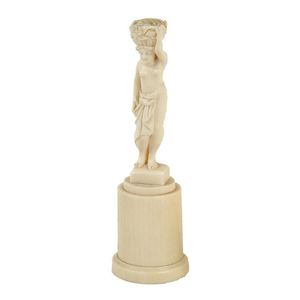Elizabethan Ivory Gentleman Sculpture
You must be a subscriber, and be logged in to view price and dealer details.
Subscribe Now to view actual auction price for this item
When you subscribe, you have the option of setting the currency in which to display prices to $Au, $US, $NZ or Stg.
- Elizabethan - Strictly speaking, furniture usually in oak, made in the reign of Elizabetht I, from 1558 to 1603. The style incororates elaborate and ostentatious carving of classicial figures and themes and bulbous baluster legs, with an Italian Renaissance influence. When a piece is described as "Elizabethan style", it mimics the attributes of the Elizabethan period, but was made at a later date.
- Ivory - Ivory is a hard white material that comes from the tusks of elephants, mammoth, walrus and boar, or from the teeth of hippopotamus and whales. The ivory from the African elephant is the most prized source of ivory. Although the mammoth is extinct, tusks are still being unearthed in Russia and offered for sale.
Ivory has been used since the earliest times as a material for sculpture of small items, both in Europe and the east, principally China and Japan.
In Asia ivory has been carved for netsuke, seals, okimono, card cases, fan supports, animals and other figures and even as carved tusks.
In the last 200 years in Europe ivory has been used to carve figures, for elaborate tankards, snuff boxes, cane handles, embroidery and sewing accessories, in jewellery and as inlay on furniture. Its more practical uses include being used for billiard balls, buttons, and a veneers on the top of piano keys.
The use and trade of elephant ivory have become controversial because they have contributed to Due to the decline in elephant populations because of the trade in ivory, the Asian elephant was placed on Appendix One of the Convention on International Trade in Endangered Species (CITES), in 1975, and in January 1990, the African elephant was similarly listed. Under Appendix One, international trade in Asian or African elephant ivory between member countries is forbidden. Unlike trade in elephant tusks, trade in mammoth tusks is legal.
Since the invention of plastics, there have been many attempts to create an artificial ivory - Ebony - Ebony is a close grained timber, black in colour. It has a fine texture which can be polished to a high gloss, making it suitable for venereering, inlay and stringing and its use as solid timber is resticted to small decorative items and ornamental decoration, such as chess pieces and musical instrument parts. The term "ebonised" means "faux ebony", timber that has been darkened during the polishing process to resemble ebony.
This item has been included into following indexes:
Visually similar items

A 19th century small carved ivory figure of a classical Grecian woman, she holds with one hand a floral basket to her head, raised on a square block and plain circular section column. Height 15.7 cm

Cambodian stone carved Buddha head. On wooden stand. Height 36 cm, including stand) 25 cm, (without stand)

A Chinese carved Shoushan stone figure of Louhan with red and dark patination. Signed with character marks to verso. Height 16.5 cm

A carved solid ivory figurine of Kuanyin, she stands holding a bunch of flowers, hair in an elaborate top knot, attached to a turned wooden base, some damage. Height on stand 35 cm
